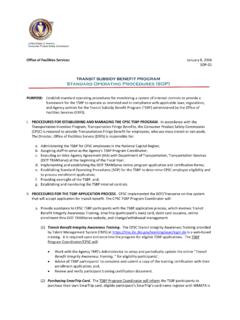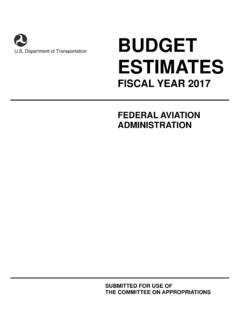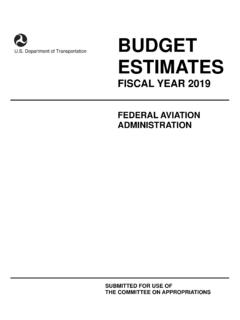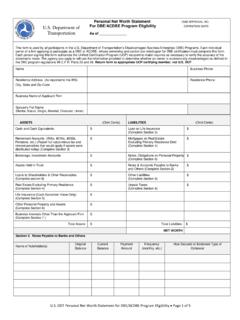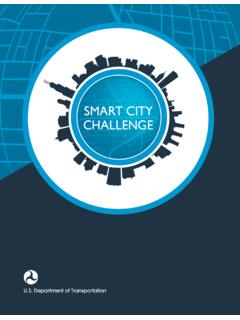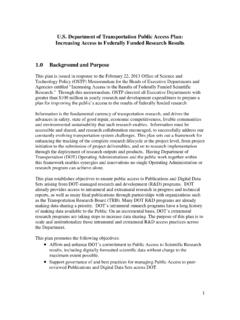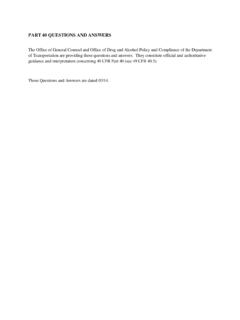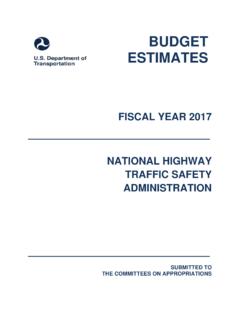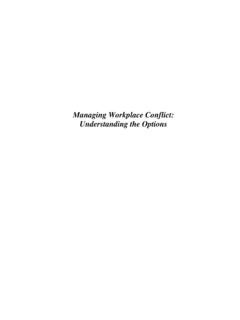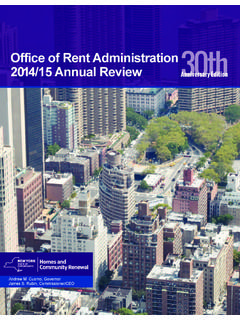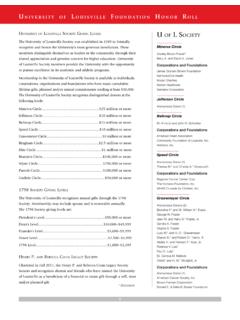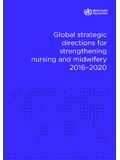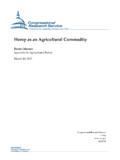Transcription of U.S. Department of Transportation Climate …
1 2014 DOT Climate Adaptation Plan Page 1 Department of Transportation Climate Adaptation Plan 2014 Ensuring Transportation Infrastructure and System Resilience 2014 DOT Climate Adaptation Plan Page 2 _____ (back page of cover page) 2014 DOT Climate Adaptation Plan Page 3 Table of Contents 1. 5 2. Identification and Assessment of Climate Change Related Impacts on the Risk of the Agency's Ability to Accomplish Its Missions, Operations and Programs ..5 Figure 1: Notable Potential Impacts .. 7 Figure 2: Severe Weather Example Superstorm Sandy .. 11 3. Description of Programs, Policies, and Plans the Agency has Already Put in Place, as well as Additional Actions the Agency Will Take, to Manage Climate Risks in the Near Term and Build Resilience in the Short and Long Term.
2 12 Figure 3: Selected DOT Climate Adaptation Outreach and Education .. 14 4. Description of Agency Response to Significant Climate Change Risk .. 14 5. Description of how the Agency Will Consider the Need to Improve Climate Adaptation and Resilience, Including the Costs and Benefits of Such Improvement, with Respect to Agency Suppliers, Supply Chain, Real Property Investments, and Capital Equipment Purchases such as Updating Agency Polices for Leasing, Building Upgrades, Relocation of Existing Facilities and Equipment, and Construction of New Facilities .. 15 6. Highlights from DOT Modal A dminist rations Accomplishments in FY 2012 and FY 2013 and Planned Future Goals .. 16 Federal Aviation Administration (FAA).
3 16 Federal Highway Administration (FHWA) .. 18 Federal Transit A dministration (FTA) .. 20 Saint Lawrenc e S eaway Deve lopment Cooperation (SLSDC) .. 22 Federal Railroad A dministration (FRA) .. 23 Federal Mot or Carrier S afety Administration (FMCSA) .. 24 Maritime A dministration (MARAD) .. 25 Pipe lines and Hazardous Materials Safety Administration (PHMSA).. 26 Office of the Secretary ( OST) .. 27 7. Response to Comments Received on the DOT 2012 Adaptation Plan .. 28 2014 DOT Climate Adaptation Plan Page 4 (back page of Table of Contents) 2014 DOT Climate Adaptation Plan Page 5 1. Introduction Pursuant to Executive O rders No. 13514 and 13653, as well as Council on Environmental Qualit y (CEQ) Implementing Instructions, the Department of T ransportation (DOT) is required to submit a C limate Adaptation Plan.
4 DOT s work on Climate a da ptation began with the understanding that Climate impacts will affect D OT s st rategic goa ls of s afety, state of good repair a nd environmental sustainability. This plan is an update from the 2012 DOT Climate Adaptation Plan, which includes the new requirements of 13653 and guidance from CEQ. It reflects FY2013 and FY2014 commitments as well as other D OT accomplishments. This ada ptation plan is organized into sections based on the guidance from CEQ and describes steps DOT will take to move towards fully integrating considerations of c limate c ha nge adaptation and resiliency into DOT policies, programs, and operations. The Offi ce o f the Secretary a nd modal administrations are e ach playing a r ole in implementing this plan.
5 The Offi ce of Safety, Energy and Environment (OSEE), in the O ffi ce of the S ecretary (OST), coordinates DOT s actions with support from the DOT s Climate C ha ng e Cent er, staffed from the Office of the Assistant Secretary for Research and Innovation, also located in OST. OSEE has participated in the Interagency Climate C ha nge A da ptation Task For ce, the related CEQ working group and the community of p ractice. DOT staff has present ed wor k on regional impacts, pilots and best practices befor e F ede ral f orums and with Federal age nc ies in orde r to share infor mation and excha nge best practices. OST s Office of the Assistant Secretary of Administration manages DOT s facilities and assets across the country.
6 The DOT administrations listed below have c ommitted to fulfilling specific actions related to DOT s high- leve l priority a ctions. Most DOT administrations report progress on ada ption actions along with other r egul atory and sustainability actions to the D eputy S ecretary at r egul arly sche duled meetings. Federal Aviation Administration (FAA) Federal Highway Administration (FHWA) Federal Transit Administration (FTA) Federal Railroad Administration (FRA) Federal Motor Carrier Safety Administration (FMCSA) Maritime Administration (MARAD) Pipeline and Hazardous Materials Safety Administration (PHMSA) Saint Lawrence Seaway Development Corporation (SLSDC) 2. Identification and Assessment of Climate Change Related Impacts on the Risk of the Agency s Ability to Accomplish Its Missions, Operations and Programs DOT s mission is to serve the United States by ensuring a fast, safe, efficient, accessible and convenient Transportation system that meets our vital national interests and enhanc es the qualit y of life of the American people, today and into the future.
7 The D epa rtment and its modal a genc ies oversee the s afe operation of the United States Transportation system including more than 2014 DOT Climate Adaptation Plan Page 6 million miles of public r oads, 120,000 miles of major railr oads, 25,000 miles of commercially na vi gabl e w aterways, 5,000 public-use a irports, 500 major u rba n public transit operators and more than 300 coa stal, Great Lakes, and inland waterways Scientists have c oncluded that some l eve l of Climate c ha nge is a lready occur ring. Weather pa tterns are c ha nging, and these c ha nges are expected to continue or a ccelerate in the The Third National Climate Assessment concludes that higher temperatures, increased atmospheric water vapor, rising sea levels, and the frequency of extreme weather events over the past 50 years have resulted from increased levels of greenhouse gases emitted from human Past weather and Climate patterns appear t o be much less reliable indicators of f utur e weather and Climate than in recent decades, which makes greater f lexibility in planning and decision-making pr oc esses ever more important.
8 Transportation is and will continue to be affected by Climate c ha nge (See Figure 1: Notable Potential Impacts). While mitigating Transportation contributions to greenhouse gas emissions and ada pting to Climate impacts on the Transportation system are e qually important for the Transportation sector to address, and the Department is engaged in a wide variety of activities meeting each goal, this plan addresses ada ptation work only. 1 Source: 2 I ntergovernmental Panel on Climate Change. Climate Change 2013: The Physical Science Basis: Contribution of Working Group I to the Fifth Assessment Report of the Intergovernmental Panel on Climate Change.
9 2013. and Global Change Research Program. Climate Change Impacts in the United States: National Climate Assessment. 2014 . 3 Walsh, J., D. Wuebbles, K. Hayhoe, J. Kossin, K. Kunkel, G. Stephens, P. Thorne, R. Vose, M. Wehner, J. Willis, D. Anderson, S. Doney, R. Feely, P. Hennon, V. Kharin, T. Knutson, F. Landerer, T. Lenton, J. Kennedy, and R. Somerville, 2014 : Ch. 2: Our Changing Climate . Climate Change Impacts in the United States: The Third National Climate Assessment, J. M. Melillo, Terese ( ) Richmond, and G. W. Yohe, Eds., Global Change Research Program, 19-67. 2014 DOT Climate Adaptation Plan Page 7 Figure 1: Notable Potential Impacts DOT recognizes that c limate variability and cha nge pose threats to Transportation systems.
10 The range o f impacts from these threats may include r oa dway deterioration, flooding, limited waterway access, a nd weakene d structures. Severe c onditions may reduce the life of capital assets and increase operational disruptions. Some c onsequenc es may require c ha nges in the de sign, c onstruc tion, and maintena nc e of infrastruc ture. For e xample, incor poration of c ertain materials and building techniques will ena ble i nfrastruc ture to bette r withstand extreme conditions. DOT s modal a dministrations are t aking steps to address the impacts of Climate c ha nge on their respective missions, which, in turn, address many of DOT s overarching vulnerabilities. These steps vary among modes, but collectively substantial effor t is foc us ed on adapting to Climate variability and cha nge implications.
